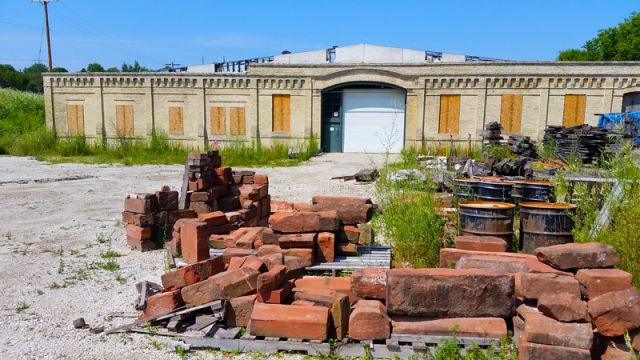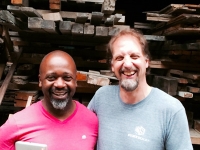The tale starts on an intuitive hunch from a guy named Mike, a new volunteer at the Urban Ecology Center. This winter Mike reached out to Judy, the Center’s Director of Finance and Operations and the project manager for our Riverland Project, with a simple request. Ginger, former Director of Development and Marketing, suggested he get involved with the project and see the scope of the Pieter Godfrey collection. Quoting Judy from the encounter: “Like others I’ve taken through the buildings, I think Mike felt a little overwhelmed on his first visit in January -- understandable as every time I walked through, I felt overwhelmed too!”
A little back story: The Riverland Project is our name for the four and a half acres we purchased from the estate of the late Pieter Godfrey in December. This is the property that lies in the middle of the Milwaukee Rotary Centennial Arboretum between our Riverside Park branch and the Milwaukee River. With this sale we purchased two large cream-city brick warehouses in various stages of disrepair absolutely jam packed with materials from the reclamation business that Pieter ran for over 25 years. It's a football field sized space with neatly stacked lumber, a variety of older tools, a restored saw mill, 200 plus doors, piles of stone, pallets of brick, and other random "stuff" in some cases stacked 20 feet high.
A panorama view from the top of the tower at our Riverside Park building. The Riverland property is shown in the middle surrounded by the Milwaukee Rotary Centennial Arboretum. Downtown Milwaukee is at the left end of the image and Riverside University High School is shown at the right end. Click image to enlarge.
As quantities of any one item are small, these are the things that Pieter, before his passing, had yet to sell. It is what was left of his collection after those running his estate, prior to our purchase, had already sold the "easy-to-sell" stuff. The question for us was what do we, a dedicated group trained to run an environmental education nonprofit, do with all the "hard-to-sell" materials of a business we know nothing about? We met with auction houses and experts in reclaimed material and even they did not know how to value much of what we had other than to say ... "Well there is certainly value in there" with the caveat that a lot would likely need to be thrown away. Thanks guys, we kinda knew that.
Then, the moment of serendipity occurred. From Judy: “I was in New York in late April for a funeral and about to board my plane at LaGuardia International Airport to head back to Milwaukee. As I stood in line, reading my book and paying no attention to anything else, I heard my name. I looked up, recognizing the person standing in line behind me but not placing him immediately. ‘I’m Mike.’ he said. Right – how strange to bump into him there! But he continued,
‘I can’t believe I’m running into you. I’m out here for a project and I just talked to the person who could have interest in all of your materials. I just saw him on this trip and now I’m seeing you. I can't believe it!’”
And that, my friends, is how we ultimately met Theaster Gates.
Gates was trained as a potter, but his artistic practice includes, among many things, sculpture, musical performance, installation and something that has been called large-scale urban intervention. He revitalizes distressed urban areas through art and recycled architecture while setting up locally run art studios (not too dissimilar from what we do using the environment as a context to revitalize neighborhoods). Last fall he was named one of the top 40 most powerful artists in the US by ArtReview. With installations internationally, he is currently focusing on projects in Chicago, St. Louis and Omaha.
Mike had seen Theaster in New York and mentioned the project. Theaster's interest was piqued, to say the least.
Well, a few board committee strategy sessions, a weekend meeting with Mike and Theaster and some non-contentious contract negations later we are proud to announce a formal agreement has been reached between Theaster Gates Studios and the Urban Ecology Center.
Like Pieter when he was alive, Theaster employs a diverse array of people within the expanding universe he's creating. There are the teenagers on the block paid to clean up, the lead craftsman who began as a de-nailer of salvaged wood, Gates's nephew apprenticing at the workshop, metal workers, art historians, computer geeks and other creative types. As Gates puts it, "I'm creating a kind of ecology of opportunity." This is something I could easily imagine Pieter saying as well.
Theaster visited the Center on a Saturday in July and saw the unique nature of what we had. He wants to preserve the collection (tools, materials, saw mill, etc.) as a whole and use it in various community endeavors largely in Chicago, which coincidentally is where much of Pieter's collection came from. He and his team plan to honor the history of the materials, the lifetime effort of Pieter Godfrey, and use them in a way that positively creates change. We will likely, in time, engage Theaster with some installation here in Milwaukee to honor the history that Pieter preserved.

A small amount of material will be saved for future projects at the Center, but we will not be opening up the material for local sale as we had originally anticipated. We realize this may be disappointing to some in our community but this is by far the best scenario for us as both owners of the material and stewards of the property and land.
Quite a story, eh? It is hard to imagine a better ending to this one-of-a-kind challenge.
Please note: It is important for all of our neighbors and members to know. Trucks will be in an out of the Riverland property in August and September related to the moving of this extensive collection. Then later in the fall we must dismantle the lower western building. This building has been determined by engineers, developers and the City to be structurally unsound, too dangerous to leave up and too expensive to restore. However, we plan to save the upper, eastern building, and in time renovate it.






